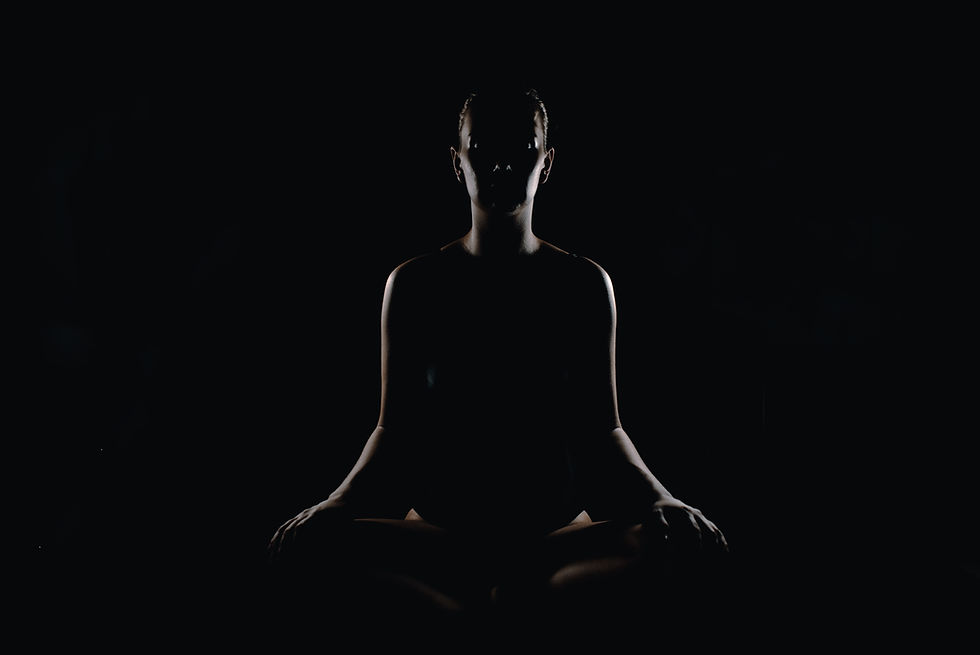Equinox & Navratri: Yoga in the Season of Turn
- Rebecca James
- Sep 19
- 4 min read

On 22st September at precisely 19:19 BST the wheel of the year pauses at a threshold: the Autumn Equinox. For a brief moment, day and night balance, before the tilt carries us into longer nights and cooler days.
This year, the Equinox falls just as Navratri begins - nine nights of honouring the Divine Feminine in India’s spiritual traditions. The two together form a powerful invitation: to steady ourselves in balance, to turn inward with reverence, and to root our practice in rhythm with both nature and the sacred.
The Equinox: Balance as Equanimity
We often think of balance as an equal split, but in yoga, balance is something deeper. It is the ability to remain centred in the shifting tides of life - stillness in motion, presence in the midst of change.
The Bhagavad Gītā gives us a definition that feels especially alive at this time of year:
“Perform your duty equipoised, O Arjuna, abandoning all attachment to success or failure. Such equanimity is called Yoga.”~ Bhagavad Gītā 2.48
This samatvam - equanimity - is what the Equinox symbolises. Equal light and darkness outside us, and the potential to hold opposites in ourselves with steadiness.
From the lens of the nervous system, the Equinox mirrors the balance we long for between activation and rest. Modern life often leaves us tipped too far into sympathetic drive (the stress response). Yoga practices such as alternate nostril breathing (nāḍī śodhana), restorative postures, and savāsana help us return to parasympathetic calm. On this day of balance, a simple ritual might be to step outside, breathe three steady breaths, and feel both light and shadow across your skin.
Navratri: Nine Nights of the Goddess

This year, as the Equinox sets in, Sharada Navratri begins - one of the most celebrated festivals in the Hindu calendar. Navratri literally means “nine nights,” and across India it is marked in diverse ways: through dance, fasting, worship, and ritual.
Traditionally, Navratri honours the Goddess in her many forms. Across the nine nights, different aspects of Durgā, the fierce protector, Lakṣmī, the bringer of abundance, and Sarasvatī, the goddess of wisdom, are celebrated. Together they represent the fullness of Śakti, the divine feminine energy that animates life.
“Navratri is a period of nine days celebrating the Divine Feminine. Without the feminine, the masculine cannot be.”~ Sadhguru
For us as practitioners of yoga, acknowledging Navratri can be a way of remembering that yoga is not only movement or breath but devotion, reverence, and relationship with the sacred. To honour the Goddess is to honour the energy that flows through all creation - fierce and soft, radiant and hidden, outer and inner.
There are gentle, accessible ways to weave this into personal practice: lighting a candle, sitting quietly with breath, chanting a mantra if that feels resonant, or journaling with the question: Which form of the Goddess do I most need to call on right now? Protection, abundance, wisdom?
And there is sound. In yogic thought, nāda - vibration, sound - is seen as a manifestation of the Goddess. This ties seamlessly to practices of sound healing, chanting, and deep listening. Our upcoming All Night Gong Puja rests in this same spirit: a night-long immersion in vibration, held as sacred.
Autumn: The Season of Release

While the calendar marks balance, the body knows change. Autumn carries us toward letting go. Leaves crisp and fall. The air shifts to cool and dry. Harvest is gathered, and the cycle of growth winds down.
The Taittirīya Upaniṣad reminds us of the intimate link between sustenance, season, and self:
“From food are beings born; by food, they live; into food they enter at their death.”~ Taittirīya Upanishad 2.7.1
This verse is about nourishment - the harvest that sustains, the cycles that carry us. Autumn is the time to slow, to ground, to replenish. In Ayurveda, autumn is understood as vāta season - airy, dry, mobile. When vāta predominates, we may feel restless, scattered, depleted. Countering this with warmth, routine, and stillness is essential.
Yoga meets this need beautifully. Gentle forward folds, supported yin postures, long savāsanas, and grounding pranayama (like brahmari or humming bee breath) restore calm. Off the mat, simple rituals - warm teas, oil massage, early evenings - create steadiness. A candlelit journal practice, writing down one thing to release with the season, can anchor the transition.
Weaving the Threads: Balance, Shakti, and Release

The Equinox invites balance and equanimity. Navratri invites devotion to the Goddess and recognition of our inner power. Autumn invites letting go, grounding, and renewal.
Together they remind us: yoga is not just posture or exercise. It is relationship to time, nature, and the sacred. To practise yoga is to live in rhythm - with breath, with season, with the unseen.
B.K.S. Iyengar expressed this integration simply:
“Yoga teaches us to cure what need not be endured and endure what cannot be cured.” ~ B.K.S. Iyengar, Light on Yoga
To “endure what cannot be cured” requires equanimity; to “cure what need not be endured” requires discernment. Both are alive in this season of threshold.
Reflection & Community Practice

As we step into the darker half of the year, a question arises:
What wisdom is asking to be heard in this season of balance and turning inward?
At Sarvāṅga we are holding this question through our practices and gatherings. The All Night Gong Puja (4 Oct)immerses us in vibration as sacred sound. Conscious Connected Breath with Lily (12 Oct) invites us to meet the breath as guide. This month we also hold a Throat Chakra Sound Bath (Weds 22nd & Thurs 23rd) - a chance to soften into the vibration of the voice, clearing space for truth to rise as the veils grow thin. Deep Rest with Tanya (24 Oct) offers the practice of profound release.
These are not just events, but shared rituals — ways of being together in balance, devotion, and seasonal rhythm.
We invite you to join us. To steady, to honour, to let go.






Comments